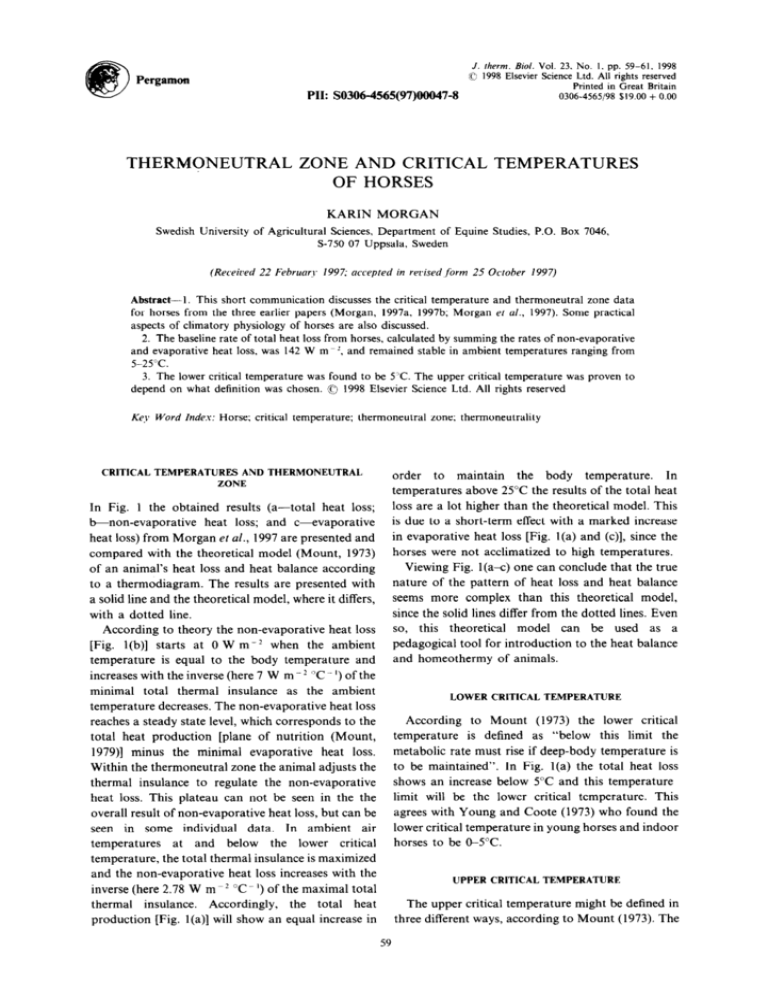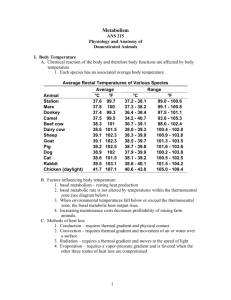
J. fherm. Biol. Vol. 23, No. I. pp. 59-61, 1998
0 1998 Elsevier Science Ltd. All rights reserved
Printed in Great Britain
0306-4565198 $19.00 + 0.00
Pergamon
PII: SO306-4565(97)00047-8
THERMONEUTRAL
ZONE AND CRITICAL TEMPERATURES
OF HORSES
KARIN
MORGAN
Swedish University of Agricultural Sciences,
Department
of Equine
S-750 07 Uppsala, Sweden
(Received 22 Februmy~ 1997; accepted in rwised,form
Studies,
P.O. Box 7046,
25 October 1997)
Abstract-l.
This short communication
discusses the critical temperature
and thermoneutral
zone data
for horses from the three earlier papers (Morgan,
1997a, 1997b; Morgan et al., 1997). Some practical
aspects of climatory physiology
of horses are also discussed.
2. The baseline rate of total heat loss from horses, calculated by summing the rates of non-evaporative
and evaporative
heat loss, was 142 W m-‘, and remained stable in ambient temperatures
ranging from
5-25°C.
3. The lower critical temperature
was found to be 5’C. The upper critical temperature
was proven to
depend on what definition was chosen. 0 1998 Elsevier Science Ltd. All rights reserved
Key Word Index: Horse;
critical
temperature;
thermoneutral
CRITICAL TEMPERATURES
AND THERMONEUTRAL
ZONE
In Fig.
1 the obtained
&non-evaporative
heat
loss;
with the theoretical
of an animal’s
model (Mount,
According
total
is due to a short-term
in evaporative
and
horses
1973)
according
with
seems
more
the
insulance
as the
heat
production
1979)] minus
the
minimal
Within the thermoneutral
thermal
insulance
[plane
of nutrition
evaporative
heat loss
pedagogical
ambient
metabolic
loss.
that the true
of heat loss and heat balance
than
this
theoretical
model,
to the heat balance
of animals.
to Mount
is defined
shows an increase
the non-evaporative
limit
(1973) the lower critical
as “below this limit the
rate must rise if deep-body
to be maintained’.
temperature
In Fig. l(a) the total
is
heat loss
below 5°C and this temperature
will be the lower
critical
temperature.
This
agrees with Young and Coote (1973) who found the
lower critical temperature in young horses and indoor
horses
at and below
the lower
critical
the total thermal insulance is maximized
and the non-evaporative
inverse (here 2.78 W m
increase
to high temperatures.
one can conclude
tool for introduction
According
temperature
(Mount,
heat loss. This plateau can not be seen in the the
overall result of non-evaporative
heat loss, but can be
seen in some individual
data.
In ambient
air
temperatures
temperature,
model. This
LOWER CRITICAL TEMPERATURE
zone the animal adjusts the
to regulate
complex
and homeothermy
ambient
heat
In
since the solid lines differ from the dotted lines. Even
model
can be used as a
so, this theoretical
temperature decreases. The non-evaporative
heat loss
reaches a steady state level, which corresponds
to the
total
temperature.
effect with a marked
were not acclimatized
Viewing Fig. l(a-c)
model, where it differs,
when
body
heat loss [Fig. l(a) and (c)l, since the
of the pattern
at 0 W m-l
thermal
the
above 25°C the results of the total heat
loss are a lot higher than the theoretical
loss;
temperature
is equal to the body temperature
and
increases with the inverse (here 7 W m - ’ “C _ ‘) of the
minimal
maintain
nature
to theory the non-evaporative
starts
to
temperatures
c-vaporative
The results are presented
a solid line and the theoretical
with a dotted line.
l(b)]
and
heat
heat loss and heat balance
to a thermodiagram.
[Fig.
(a-total
et al., 1997 are presented
heat loss) from Morgan
compared
results
order
zone; thermoneutrality
heat loss increases with the
2 “C _ ‘) of the maximal total
to be O-5%
UPPER CRITICAL TEMPERATURE
thermal
insulance.
Accordingly,
the total
heat
production
[Fig. l(a)] will show an equal increase in
The upper critical temperature might be defined in
three different ways, according to Mount (1973). The
59
K. Morgan
60
a: Total heat loss
the construction
n” 500
k 400
of
??
upper
whether
or not
and
which physiological
production.
-5
0
5
10
20
15
25
30
35
40
minimal,
(1987)
!piii
-5
0
. . . .
. .
.
.
.
.
.
.
.
.
heat loss
.
.
.
.
.
.
10
15
20
25
30
35
of Worstell
Brody
(1953)
occurs
before
has reached
value, so
ct d.
McBride
(1983)
5
10
15
20
25
30
35
defined
Christopherson
defined
thermoneutral
the
in which
show relationship
total; (b) non-evaporative;
and (c) evaporative
ambient
The
dotted
between (a)
heat loss and
lines represent
model [according to a thermodiagram
the solid
lines and
(Morgan
data
points
the
by Mount
are
results
(‘I t/l.. 1997).
in the
and
of heat
heat
primarily
short
term
transfer
production,
of
and
postural
present
range
maintains
with
of
body
little
or no
In the TNZ physical
occur
in the
these
responses
blood
flow
changes.
definition
of Christopherson
general thermoneutral
zone
(1986)
as the
an animal
variation
piloerection,
Young
zone
energy expenditure.
processes
balance
air temperature.
the thermoneutral
- I5 C and 10 C in still air
conditions.
additional
40
Ambient air temperature [OC]
The three diagrams
ZONE
lone (TNZ) as related to minimal metabolic rate and
concluded that the thermoneutral
zone for the horses
temperature
and
the minimum
THERMONEUTRAL
temperatures
(1973)]
show that
insulance is
and
in the study was between
theoretical
temperature
that the onset of sweating
40
c: Evaporative heat loss
Fig. I.
on
e.g. heat
occur together.
5
0
or rectal
of
that control of heat loss by sweating and vasodilation
.
Ambient air temperature [“Cl
-5
depending
one chooses,
rate
to
to be a problem
which agrees with an analysis by McArthur
of the data
tissue resistance
. . .
Estimates
according
will differ
parameter
respiratory
confirming
I..
vary
(Webster.
1991). The present
results
sweating occurs before the tissue thermal
Ambient air temperature [“Cl
b: Non-evaporative
definition.
temperature
heat stress is considered
productivity
f
of an absolute
critical
body
to
the
Based
to
being
skin,
on the
and Young (1986) a
for the horses in the
study can be estimated.
from the range
of
steady state level of rate of total heat loss in Morgan
ct cd. (1997) to range from 5-25 C. However,
upper
critical
temperature
?? the
temperature
is defined
as the ambient
when:
metabolic
rate increases:
the results:
is considered
to
follow the total heat loss (Morgan PI u/., 1997);
2. 20 C when the evaporative
heat loss increases
(Morgan et rtl., 1997): and
3. 30 ‘C when peripheral
(i.e. minimal
thermal
(Morgan, 1997b).
from this estimated
deviations
temperature
will differ when viewing
rate
individual
vasodilation
insulance
of
is maximal
the
tissue)
upper
that it is hard to establish
critical
temperatures
show
an uniform
definition
for
the upper critical temperature. Webster (1991) argued
that the upper critical temperature is not amenable to
this will
will have
thermoneu-
also
The
reflects a
span
of
zone was 25°C in
et ml. (1983) and 2OC in the
study. According
to Cena and Clark (1979) most
homeotherms
have a narrow thermoneutral
zone,
and wider temperature
ranges and lower critical
temperature
are associated
with
both
greater
insulation
and size. The rather
wide range in
thermoneutral
zone of horses is associated
a fairly well insulated
with being
large homeotherm.
PRACTICAL
These different
1997a)
5-25 C.
in the thermoneutral
the study of McBride
that
that the steady state level of
the heart rate (Morgan,
thermoneutrdl
zone
of
evaporative
heat loss increases; or
?? the tissue thermal
insulance is minimal
I. 25 C if the metabolic
for the horses,
tral zone. It is noticeable
?? the
These three temperatures
be a generalization
ASPECTS
The thermoneutral
zone, the non-evaporative
and
evaporative
heat loss, together
with the design
and construction
of the building will affect the
Thermoneutral
zone and critical temperatures of horses
microclimate in a stable. The ambient air temperature
in the stable should be regulated to fall within the
thermoneutral zone so as to be thermally neutral for
the horse. During the winter season the ventilation
rate is regulated to remove moisture and carbon
dioxide. The non-evaporative
heat loss from the
horse in relation to heat loss through the building
fabric and in the exhaust air is used to calculate the
need for additional heating. The optimal set-point for
the ambient air temperature in the stable during the
cold season is just above the lower critical
temperature of the horse. The evaporative heat loss
will then be minimal and the non-evaporative heat
loss will contribute positively to the heat balance of
the stable. Ventilation rate and extra heating will be
minimized, which saves money. In the warm season,
the main purpose of ventilation will be to limit the
temperature increase in the stable in relation to the
outside ambient air temperature.
Altered insulation by shearing and covering was
studied (Morgan, 1997a). In the cold season it can be
of advantage to shear horses that are exercised and
trained for competitions, since according to Cena and
Clark (1979) hairlessness is an advantage
in
facilitating sweating, which can be of importance for
the exercising horse. Also, the managing of the horse
is facilitated and one might speculate on a faster
recovery after exercise. When the ventilation rates are
controlled to exhaust moisture and carbon dioxide, a
decreased evaporative heat loss like in a sheared
horse is an advantage, since the ventilation rates can
be keep down. The increased non-evaporative heat
loss in a sheared horse will be favourable for the
climate, since heat from the horses will keep the
indoor
temperature
that a sheared
feeding
up. It is important
to point out
horse needs a rug or complementary
to ensure
that
it can maintain
body
core
temperature.
SUMMARY
The thermoneutral zone, defined as the range of
temperatures in which an animal maintains body
temperature in the short term with little or no
additional energy expenditure, was estimated in
general for these horses to range from 5-25°C. It was
shown that the upper critical temperature is hard to
61
define and varied between 20°C 25°C and 30°C
depending on definition. From the discussion on
upper critical temperature, it was concluded that
onset of sweating occurred before tissue insulance
had reached the minimum value, so that control of
heat loss by sweating and vasodilation occurred
together.
REFERENCES
Cena, K. and Clark, J. A. (1979) Transfer of heat through
animal coats and clothing. In Inrernational Review of
Physiology.
Environmenral Physiology III, ed. D.
Rohertshaw, Vol. 20, pp. 142. University Park Press,
Baltimore, USA.
Christopherson, R. J. and Young, B. A. (1986) Effect of cold
environments on domestic animals. In Grazing Research
at Northern Latitudes, ed. 0. Gudmundsson. Nato AS1
Series, pp. 247-257. Plenum Press, New York.
McArthur, A. J. (1987) Thermal interaction between animal
and microclimate: a comprehensive model. J. Theor. Biol.
126, 203-238.
McBride, Cl. E., Christopherson, R. J. and Sauer, W. (1983)
Metabolic rate and thyroid hormone concentrations of
mature horses in response to changes in ambient
temperature. Can. J. Anim. Sci. 6S., 375-382.
Morgan, K. (1997a) Effects of short-term changes in
ambient temperature or altered insulation in horses. J.
Therm. Biol. 22, 187-194.
Morgan, K. (1997b) Thermal insulance of peripheral tissue
and coat in sport horses. J. Therm. Biol. 22, 1699175.
Morgan, K., Ehrlemark, A. and Sallvik, K. (1997)
Dissipation of heat from standing horses exposed to
ambient temperatures between - 3°C and 37°C. J.
Therm. Biol. 22, 1777186.
Mount, L. E. (1973) The concept of thermal neutrality. In
Heat Loss from
Conrrol. eds. J.
Animals
and
Man-Assessment
and
L. Monteith and L. E. Mount,
pp. 425435. Butterworths, London.
Mount, L. E. (1979) Adaptation to Thermal Environment of
Man and his Productive Animals. Edward Arnold,
London.
Webster, A. J. F. (1991) Metabolic responses of farm
animals to high temperature. EAAP Publ. 55, 15-22.
Worstell, D. M. and Brody, S. (1953) XX. Comparative
physiological reactions of European and Indian cattle to
changing temperature. In Environmental Physiology and
Shelter Engineering. Research bulletin 515. University of
Missouri, College of Agriculture, Agriculture Experimental Station.
Young, B. A. and Coote, J. (1973) Some Ejjeects of Cold on
Horses. Horse Report at Feeders’ Day. University of
Alberta, Department of Animal Science, Edmonton.
Alberta.







